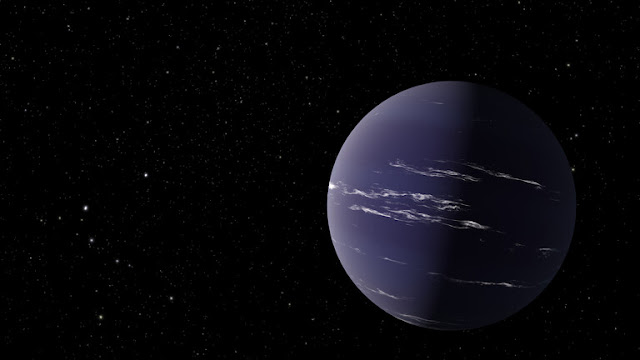The discovery of an exoplanet the size of Neptune with an "unknown" atmosphere that may contain water vapor
 |
NASA/JPL-Caltech .Graphic image of TOI-1231 b, the Neptune-like planet about 90 light-years from EarthA new exoplanet discoveryAstronomers have identified a new Neptune-sized exoplanet with a "large atmosphere", and its clouds may contain water vapor, according to a new study. Known as TOI-1231 b, the exoplanet has a 24-day orbit around its star, TOI-1231, and could have an atmosphere similar to Neptune, given its size and density. There is also the possibility of water vapor on the planet, which is 90 light-years away from Earth, which intrigues scientists. "The low density of TOI-1231 b indicates that it is surrounded by a large atmosphere rather than a rocky planet, " study co-author Diana Dragomir, associate professor in the University of New Mexico's Department of Physics and Astronomy, said in a statement. ". "TOI-1231 b could have a large hydrogen or hydrogen and helium atmosphere, or a denser water vapor atmosphere, " Dragomir continued. "Each of these elements indicates a different origin, allowing astronomers to understand whether planets form differently around Red dwarfs when compared to the planets around our sun, and how they form. Red dwarfs, or cold dwarfs (small M-type stars), are types of stars much smaller than the Sun, with masses between 8% and 50% of the Sun's mass. It is the most abundant class of stars. The exoplanet temperature and environmentWater vapor on TOI-1231 b may be just a possibility, but it's still one of the coolest exoplanets ever discovered, with a predicted temperature of 140 degrees Fahrenheit. Previous studies have suggested that planets with such a temperature can have high atmospheric clouds, but further research on K2-18 b exoplanets shows the possibility of water in the atmosphere. The exoplanet was discovered by NASA's Transiting Exoplanet Survey Satellite (TESS) , and later confirmed using the Planet Finder spectrometer aboard the Magellan Clay Telescope at Las Campanas Observatory in Chile. Studies and measurements are still going on on the planet, and they may tell us new informationThe study's lead author, Jennifer Burt, said the researchers were able to measure the radius and mass of the planet, which allowed them to theorize that it is similar in composition to Neptune. "These values, in turn, allowed us to calculate the bulk density of the planet and hypothesize what it is made of," Burt explained. Scientists hope to further examine the planet's atmosphere with the Hubble Space Telescope and the James Webb Telescope, due to launch later this year. "This new planet we've discovered is still strange, but it's a step closer to being somewhat like our neighboring planets, " Burt said. "Compared to most transiting planets discovered so far, which often have extreme temperatures of several hundred or so. Thousands of degrees, the TOI-1231 b is positively frozen." Source: Daily Mail Read Also : Big Bang | the first state of matter in the universe after it |

Comments
Post a Comment